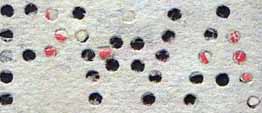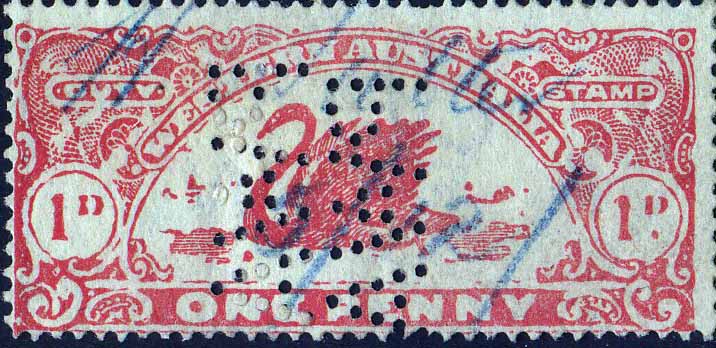|
Private Revenue Perfins of Western Australia An Elsmore Coath production The authors would welcome your comments additions or input into this work B C D F G H I K L M N O P R V W Other P -------------------------------------------------------- PWA.a Double Punch User: (P W) Armstrong & Cycle Motor Agency Bicycle and Motor Car Importer and Distributer Address: 862 Hay St, Perth, WA. also Fremantle & Kalgoorlie. Revenue Use: 1911-22 issue 1d. 1920-30 issue (mono colour) 1d. Rarity Scale: 1911-22 issue 1d R3. 1920-30 issue (mono colour) 1d R3. Background: P. W. Armstrong was born in Vlctoria, he was educated at Scotch College, Melbourne, and lived for some years in Fiji before going to Coolgardle (WA) in 1895. At that time the railway did not extend beyond Southern Cross and recognising the importance of getting messages to the mines, he organised a communication service which enabled mail to be delivered speedily by cyclists over routes later covered by rail, coach and telegraph line. He later began importing bicycles and from this initial venture built up a large motor car distributing business with branches throughout the State. Armstrong's name will always be associated with the development of road transport in Australia. As well as importing some of the earliest motor cars he set up many road records from Perth to Sydney and made the return journey 18 times, the last being at the age of 75. His first trip from Perth to Sydney in 1916 was accomplished in 9 days 23 hours, and for many years his notes on the route were used by other overland travellers. Always of an adventurous nature, Armstrong, in 1893, made what was believed to be the first bicycle ride across Australia and later covered the north-south route from the Gulf of Carpentaria. He was also founder of the big annual wheel race from Beverley to Perth. Device: The PWA.a device is a mutli head device of at least 3 and possibly 4 heads in a horizontal array. The separation between the die heads is consistent and the dies are near identical and therefore they are considered to be a single pattern listing. The device had a long life with use from about 1912 to at least 1935. However early in its use, around 1914, one of the dies starts to loose pins. It starts with the single pin of the crossbar of the A and later spreads to the left hand pins in the P and the W. Oddly this degradation seems to effect only one die in the array. The degraded die is the middle die, if the device is a 3 head one, as we have found strikes of other dies consistently space to both the left and the right of the degraded die. There is a possibility that the device has 4 heads as we have also sighted a single example of a multiple strike that shows a partial strike of a die consistently spaced to the left of die 1, that is 2 die heads to the left of the degraded die. More examples of multiple strikes would need to be seen to prove that this is a 4 head device but given the scarcity of the pattern such multiples may not be found. If the device was a 4 head one then it would be similar to the WS/&CO.a device (see W section) in its layout. However WS/CO.a is known to be a Sloper device and no record of the PWA.a is found in the Sloper workbooks. Related Patterns: Nil -------------------------------------------------------- B C D F G H I K L M N O P R V W Other © copyright 2011 |

